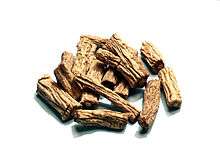Codonopsis pilosula
| Codonopsis pilosula | |
|---|---|
 | |
| Scientific classification | |
| Kingdom: | Plantae |
| (unranked): | Angiosperms |
| (unranked): | Eudicots |
| (unranked): | Asterids |
| Order: | Asterales |
| Family: | Campanulaceae |
| Genus: | Codonopsis |
| Species: | C. pilosula |
| Binomial name | |
| Codonopsis pilosula Franch. | |
Codonopsis pilosula (Chinese: 党参; pinyin: dǎngshēn), also known as dang shen or poor man's ginseng, is a perennial species of flowering plant in the bellflower family. It is native to Asia, where it grows in forests, meadows, and scrub.[1]
| Wikimedia Commons has media related to Codonopsis pilosula. |
Description
The plant produces twining stems up to 2 meters long. It has lateral branches with alternately arranged leaves and small branchlets with oppositely arranged leaves. The ovate leaves are up to 7.3 centimeters long and are usually coated with short hairs. Solitary flowers occur at the branch tips. The bell-shaped flower is about 2 centimeters long and wide and is yellow-green with purple spots inside. The fruit capsule is up to 2.4 centimeters long.[1]
Traditional uses


The roots of C. pilosula are used in traditional Chinese medicine. They are carrot-shaped or cylindrical, sometimes branched, and up to 30 centimeters long by 3 wide.[1] They are a constituent of Radix Codonopsis, an herbal mix used to improve appetite and energy.[2]
Subspecies
There are 3 subspecies:[1]
- Codonopsis pilosula ssp. handeliana (Chinese: 闪毛党参, shanmaodangshen)
- Codonopsis pilosula ssp. pilosula (Chinese: 党参, dangshen)
- Codonopsis pilosula ssp. tangshen (Chinese: 川党参, chuandangshen) - widely cultivated
References
- 1 2 3 4 Codonopsis pilosula. Flora of China.
- ↑ Li, C. Y., et al. (2009). Quality assessment of Radix Codonopsis by quantitative nuclear magnetic resonance. Journal of Chromatography A 1216(11) 2124-29.
Further reading
- Wang ZT, Ng TB, Yeung HW, Xu GJ (December 1996). "Immunomodulatory effect of a polysaccharide-enriched preparation of Codonopsis pilosula roots". Gen. Pharmacol. 27 (8): 1347–50. PMID 9304404. doi:10.1016/s0306-3623(96)00084-5.